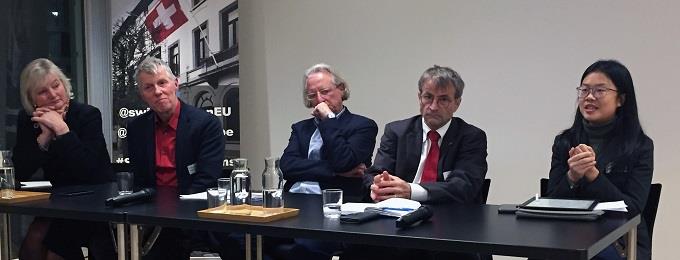Global challenges are wicked problems with high uncertainties and value conflicts. Examples from transdisciplinary research show ways to sustainable solutions.
The priorities of the new European Commission (EC) aim at tackling global challenges such as climate change or the digital transformation, and research and innovation (R&I) will play an essential role therein. Because these challenges are multifaceted and cannot be separated into simple problems, they call for a holistic approach involving multiple actors. A Science Briefing jointly organised by SwissCore, the Mission of Switzerland and the Swiss Academies of Arts and Sciences on 5 February aimed at inspiring the European R&I community with successful examples of transdisciplinary research towards sustainable solutions from Switzerland, the Organisation for Economic Co-operation and Development (OECD) and Sweden.
The Swiss Ambassador to the European Union, Urs Bucher, opened the briefing by emphasising the global nature of science. Europe will therefore also need the contribution of Member States, associated countries and third countries to address the great challenges of our time by acting as one continent. However, “international cooperation in science is not enough to create qualitatively new knowledge”, Antonio Loprieno, President of the European Federation of Academies of Sciences and Humanities (ALLEA), and moderator of the event explained. Academic traditions need to be combined with other premises in a transdisciplinary manner in order to change the way we look at problems.
Jakob Zinsstag, co-chair of the OECD Global Science Forum study ‘Addressing societal challenges using transdisciplinary research’ and president of the Network for Transdisciplinary Research (td-net) of the Swiss Academies of Arts and Sciences, presented a good example for transdisciplinarity as the result of co-production of knowledge by academic and non-academic actors. With his background as a veterinary doctor, Zinsstag also conducts a research project in Guatemala at the interface of modern and traditional Maya medicine on diseases transmitted between animals and humans. The two distinct approaches to medicine can be reconciled by integrating the patient into the decision on an appropriate care solution, which may require both, calming evil spirits as well as getting surgery. To train scientists how to work with different stakeholders such as governments, agencies and society, Zinsstag and the td-net developed a massive open online course on transdisciplinary research.
Problems with high uncertainties and conflicting values, which require a joint framing and transdisciplinary approach as explained by Michael Stauffacher from the TdLab at ETH Zurich, lie also just in front of our doorstep. Minxia Luo, a PhD student at the University of Zurich, investigates the concept of healthy ageing, a challenge for many industrialised countries. The research group she belongs to is using digitally powered real world evidence gathered from elderly citizens in order to understand their needs and to develop appropriate support measures together with a broad range of stakeholders.
Tackling complex problems in a sustainable way is not only a challenge for research, funding agencies also have to adapt their approaches. The Swedish International Development Cooperation Agency (Sida) is a pioneer, as AnnaMaria Oltorp explained, in its focus on poverty eradication and support for low-income countries. For this purpose, Sida issues calls for projects, which require a principal investigator from the social sciences who includes other disciplines and local stakeholders already at the stage of problem definition. The convening power of the researchers can break down the silo mentality among project partners and generate knowledge that is more relevant to the local context and contributes to the Sustainable Development Goals (SDGs).
Thomas Arnold from the European Commission confirmed that complex problems also occur at policy level. Solving them partially can result in new challenges. For example replacing conventional cars by electric vehicles may produce the need to build new infrastructure or test new economic models. Because sustainability issues require more systemic approaches, all priorities of the new Commission, and in particular the European Green Deal, rely on a set of deeply transformative policies and an organisational structure, which can enable realising these priorities. Arnold therefore helped to reorganise the Directorate General for Research and Innovation (DG RTD) in a matrix structure aligned with the SDGs. Transdisciplinarity is there not only for science, he concluded, it is also about how governments and even industry should operate.
At the end of the event, all participants agreed, the practical examples were inspirational and exemplified how and why a transdisciplinary approach brings value-added in addressing societal challenges. Transdisciplinarity can act as a bridge between science and citizens as well as help to ensure that new knowledge is implemented and has an impact on society. To be effective, however, scientists and funding agencies alike need a clear understanding of transdisciplinarity in order to organise and evaluate projects accordingly, and to take the right experts aboard. The way to transdisciplinary research starts with the education of students, who will have to think outside of their disciplinary specialty and receive training in communication, the arts and philosophy.
Presentations:
Jakob Zinsstag: here
Minxia Luo: here
Michael Stauffacher: here

